
We collect basic website visitor information on this website and store it in cookies. We also utilize Google Analytics to track page view information to assist us in improving our website.

Pickleball has been the fastest-growing sport in North America for three years running, with a whopping 36.5 million players in the U.S. alone and a paddle market topping $150 million. And it's not just for kids and older folks—the biggest group of players is young adults aged 18 to 34.
But there's a catch: while there are almost 14,000 places to play in the U.S., the demand for indoor pickleball courts is still skyrocketing. Pickleball enthusiasts want to play year-round, rain or shine. That's where your facility comes in.
Finding the right indoor space for pickleball, however, can be a serious challenge. Ceiling height, floor surface, lighting—there's a lot to consider. But don't worry, we've got you covered.
In this blog post, we'll walk you through the basics of creating the perfect indoor pickleball facility, and why domes are the ultimate solution.
Pickleball's explosive growth means more people are grabbing their paddles and heading to the courts. But not just any space will do. Pickleball has some unique requirements, and finding the right space to play indoors can be a pickle (pun intended.)
Many pickleball spaces we see today didn’t start out that way—they’re often commercial spaces, former offices or stores, that took a lot of TLC to make that transformation.
While these repurposed buildings might seem like an easy, affordable fix, they often fall short in key areas.
Pickleball is a game of epic lobs and smashes, so you need enough overhead clearance to avoid hitting the ceiling. Low ceilings can cramp your game and even be dangerous.
A minimum ceiling height of 18-20 feet is okay, but more is even better. Unfortunately, most existing buildings weren't designed with pickleball in mind, so finding a space with enough vertical clearance can be a challenge.
Next, pickleball courts need a wide-open playing area. A single standard pickleball court size is 44 feet long and 20 feet wide. Obviously, you can’t have columns obstructing that area.
Columns on the periphery of the court are a problem as well, making the space feel cramped and creating safety hazards for players and observers.
Again, most existing buildings weren't designed with pickleball in mind, so finding that perfect, clear-span space can be tricky.
Lighting is also important. Nobody really wants to play pickleball in a dimly lit dungeon (pickleball fanatics may settle if it’s the only game in town, but if there’s brighter competition, that’s going to draw away customers.)
Whether it's natural sunlight or artificial lighting, it needs to be bright and evenly spread across the court. Glare and shadows can be real buzzkills, making it hard to track the ball and potentially leading to accidents.
And let’s face it: pickleball is a noisy sport. The constant pop-pop-pop of the ball hitting the paddle is music to some ears, but it can be a real racket for others, especially indoors, acoustics are worth considering. So, finding a space that can handle the unique acoustics of pickleball is crucial.
With pickleball's popularity soaring, the demand for indoor facilities is also through the roof. It's a smart business move to tap into this growing market and provide a space where people can play their favorite sport year-round, regardless of the weather.
But as we've seen, finding the perfect indoor pickleball location can be like searching for a needle in a haystack. Most existing buildings just weren't built with pickleball in mind. Low ceilings, pesky columns, and lack of soundproofing can stop your venture before it gets off the ground.
But don't worry! There's a solution that ticks all the boxes and then some for pickleball perfection.
Air-supported domes are the MVPs of the pickleball world, offering a unique combination of benefits that traditional indoor spaces simply can't match!
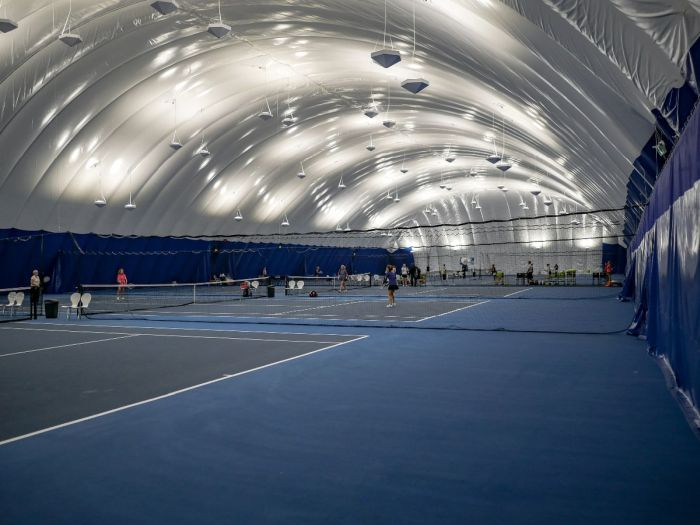
Sprawling courts at Marilyn Redvers Tennis in Aurora, Ontario
As we've seen, pickleball demands both ample ceiling height and a wide-open playing area. Air-supported domes meet those requirements and then some.
Domes have spacious, column-free interiors and soaring ceilings. You can easily fit multiple pickleball courts without worrying about obstructive columns or low-hanging beams getting in the way of your game. In fact, even our smallest domes (around 24,000 square feet) can fit around 30 pickleball courts—and our largest domes (+100,000 square feet) can fit over a hundred!
Maybe you don’t want to cram dozens and dozens of pickleballs courts under one roof. You don’t have to. It’s up to you how to use the space under your dome, and with optional dividers and netting, it’s very easy to do.
For example, the Cougar Dome hosts six full-size tennis courts (which is space for 24 pickleball courts!) as well as a synthetic turf surface for field sports, long and triple jump pits, a running track, and a 10-bay golf range. Multi-sport domes are incredibly versatile!
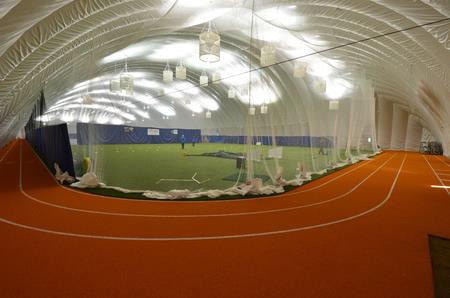
Running track separated by netting at The Cougar Dome in Truro, Nova Scotia
Plus, with ceilings typically reaching 30 feet or higher, you'll have plenty of room for those sky-high lobs and overhead smashes.
The beauty of domes is that they're completely customizable. You can design a pickleball facility from scratch, tailoring the layout and size to your specific needs and preferences. No more settling for cramped, converted spaces with awkward columns or low ceilings.
The constant pop-pop-pop of the ball hitting the paddle can get amplified in traditional indoor spaces, thanks to hard surfaces and lower ceilings. It's like playing in an echo chamber!
Air-supported domes, on the other hand, are designed to keep the noise down. Their fabric material absorbs sound, and the high ceilings help dissipate it, creating a much quieter environment for everyone. Some dome owners even install carpet for an extra layer of soundproofing.
Don't just take our word for it. Pickleball facility owners interviewed by Forbes have noticed that players stick around longer and spend more money when the noise is under control, and one owner with multiple facilities says the location with the fewest noise complaints is a converted tennis bubble!
A quieter court is a happier court, and happy players are good for business.
We mentioned how many indoor pickleball facilities are converted from existing buildings like old warehouses or retail spaces (you’ve probably encountered one yourself.) These spaces often lack natural light and can feel a bit like playing in a dungeon.
Air-supported domes, on the other hand, let the sunshine in! Domes can be designed with special translucent fabric panels that allow natural light to filter through, creating a bright and welcoming atmosphere for players. The Whitby Iroquois Soccer Club and Richmond Green Sports Centre are great examples.
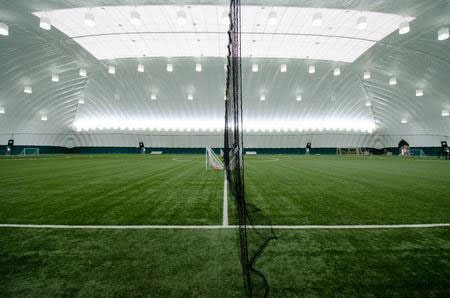
And for those cloudy days or evening games, domes are equipped with top-notch LED lighting systems designed specifically for sports, so you can always see the ball clearly and enjoy a comfortable playing experience day or night.
But let's not forget that the pickleball craze isn't just about fun and games. It's also a booming business. It's important to consider the revenue-generating potential of your pickleball facility, too—and that’s another area where domes come in clutch.
One of the biggest advantages of a dome for pickleball is its potential to bring in serious revenue. Domes aren't just for pickleball. They're versatile spaces that can host a whole range of activities—adding the potential for multiple revenue streams beyond pickleball memberships.
This could include additional sports like tennis or basketball, or even non-sporting events such as trade shows, movie nights, parties, or youth group activities. By diversifying what you offer, you can attract a wider audience and keep the revenue flowing.

Holiday fun under our manufacturing dome (yes, we made all these domes under a dome of our own!)
Dividers or netting can easily section off areas within the dome, allowing for simultaneous activities without worrying about stray pickleballs. Have a slow season or off-peak hours? Rent out unused space to other groups for activities or events, maximizing your dome's earning potential.
Looking to create a social hub for pickleball enthusiasts? Some of our domes are designed with attached clubhouses, pro shops, or even restaurants. Others offer refreshments right under the dome itself.
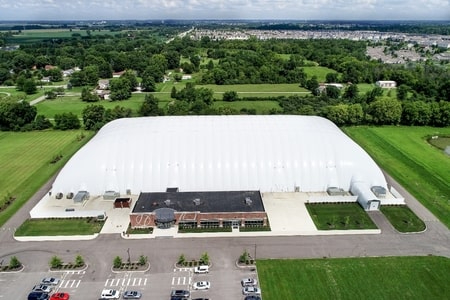
Reception area, change rooms, and pro shop attached to Bo Jackson’s Elite Sports in Hilliard, Ohio
Either way, providing food and beverages creates a welcoming atmosphere where players can relax and socialize, boosting customer satisfaction and your bottom line.
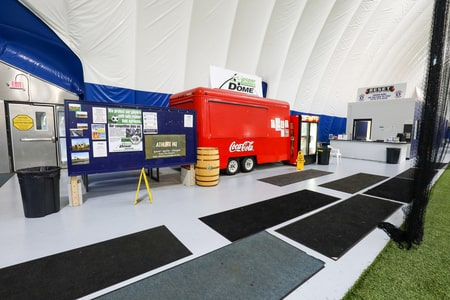
Now, let's talk about money. Building a brand-new dome might sound like a big investment, but it's often more cost-effective than trying to retrofit an existing building. Plus, you get a space that's tailor-made for pickleball!
But if you're looking for an even more budget-friendly option, consider converting an existing tennis bubble or adding pickleballs lines to existing tennis courts. Check out our blog post on how tennis clubs are retrofitting their courts to bring in pickleball players without pushing away their core tennis customers.
It's a win-win: you save on construction costs and give new life to an underutilized space.
The pickleball craze isn't slowing down, and now is the perfect time to capitalize on this growing sport. Don't let the challenges of finding the ideal indoor space hold you back! Air-supported domes offer a winning combination of space, comfort, and revenue-generating potential.
Contact The Farley Group today and let our experts guide you through the process of building the pickleball dome of your dreams.
